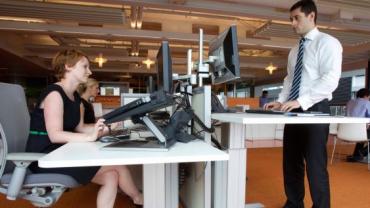
In the introduction to this series we covered the growing awareness that sedentary work is associated with a host of health complications that run the gamut from musculoskeletal pain to increased risk for diabetes and other serious cardiovascular issues. Scientific journals and the popular media alike have been bringing attention to the adverse effects of a dearth of physical movement during the day. The Washington Post put together a wonderful graphic illustrating the myriad negative consequences associated with prolonged sitting at work.
An Australian study concluded that a two-hour increase in the time spent standing or stepping per day was associated with lower triglycerides lower BMI and waist circumference lower total/HDL cholesterol ratio and lower 2-hour plasma glucose. A separate study demonstrated that intermittent bouts of standing reduce fatigue and lower back pain compared to remaining seated particularly among overweight and obese office workers.
One of the simplest ways for people to move around more is for them to set a timer on their computer or phone in order to give themselves periodic reminders to stand up and get moving. Depending on the layout of one’s work location perhaps they can go for a walk down a long hallway and back or even a walk outside around the building weather (and supervisors) permitting. If there’s no opportunity to leave the immediate area there’s nothing stopping anyone from doing air-squats jumping jacks lunges arm circles and the like in their workspace. Let coworkers chuckle; they won’t be laughing when they’re hitting the vending machine for their 3 o’clock pick-me-up while someone else is refreshed and energetic after a 5-minute bout of cubicle calisthenics—no sugar required! The Washington Post has a helpful guide to exercises that can be done in a small space to help circulation and get desk jockeys moving.
Another way office workers are counteracting their sedentary jobs is by using stand-up desks. An entire industry that didn’t exist just a few years ago has built up around the demand for desks that allow people to comfortably stand or in the case of treadmill desks walk while they work. It might be difficult to adjust to reading and typing while in motion but it’s not likely that anyone is trying to set personal speed records while doing their work. Even that which would otherwise be considered a slow pace—such as 2 miles per hour—can add up to several miles walked over the course of a day and it would still allow someone to accomplish their work.
It is critically important that sedentary workers find ways to inject short but frequent bouts of movement into their day. Studies indicate that among people who are otherwise sedentary even a dedicated workout a few times a week may not be enough to counteract the effects of sitting too much at all other times. Prior to the developments in telecommunications that now have many people sitting nearly all day non-exercise activity thermogenesis (NEAT) may have been a more significant aspect of the physical movement people engaged in throughout the day simply by going about their everyday lives. NEAT is not something sedentary individuals need to allot specific time for but until moving a little more becomes second nature it may help for them to be aware of how much time they’ve spent seated and that it would be beneficial for them to get up and move around. In the context of an office or just a daily routine at home creating pockets of movement requires nothing more than when possible walking to do errands rather than driving standing up or pacing while on the phone choosing to carry heavy items out of the grocery store rather than using a shopping cart and bosses permitting having “walking meetings” to discuss work rather than sitting around a conference room table.
Bottom line: fancy contraptions like treadmill desks are absolutely not required to be more active during the day and workers whose jobs really do require significant time seated are not doomed to experience poor health. All they need is awareness of how much they’re sitting and a willingness to get up and move around a little more. This may take a conscious effort at first but over time it will become a new habit and once workers become accustomed to more frequent movement they might find their own bodies signal to them when it’s time to stand up for a while.
Lest anyone walk away—no pun intended—with the mistaken idea that if being sedentary is so detrimental to health then being on their feet and moving around all day is the answer the next installment will explore some of the negative impacts of not sitting and resting enough.